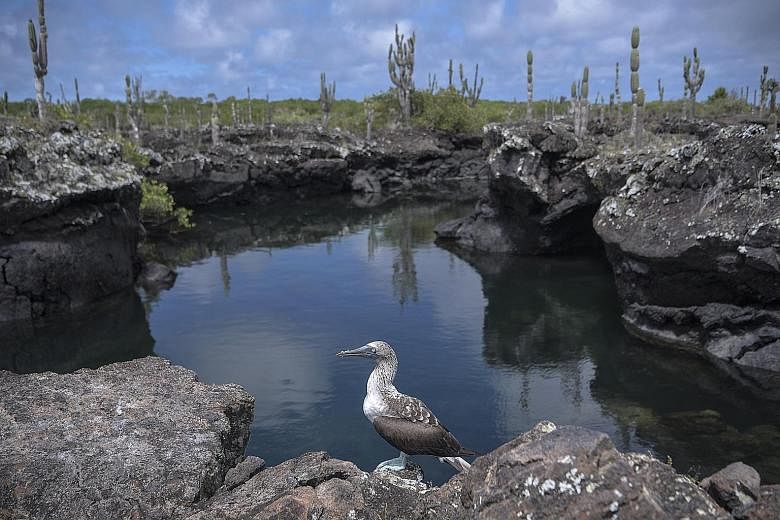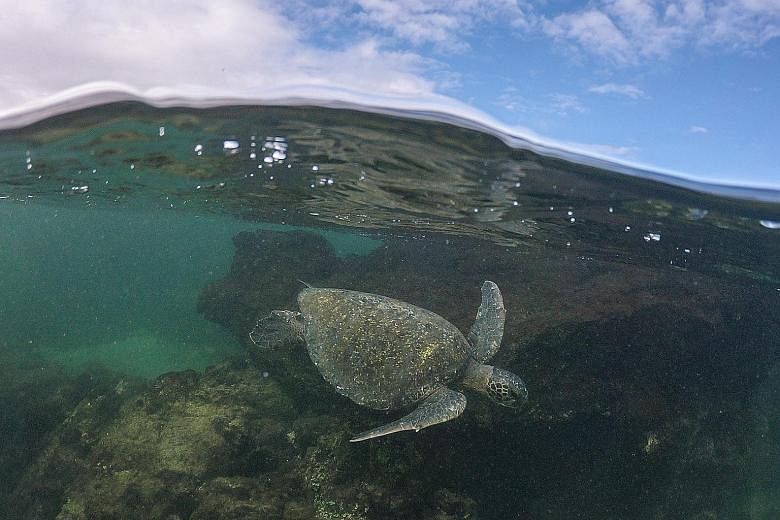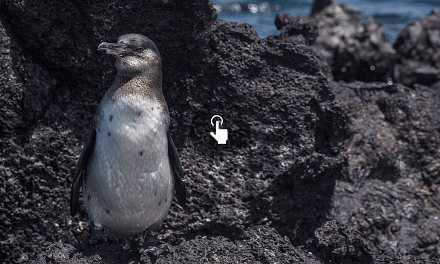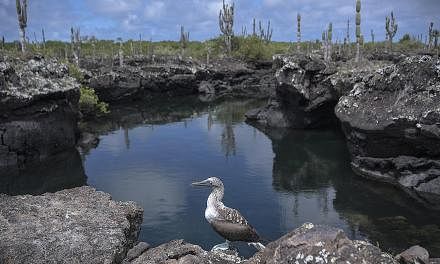It was raining when we arrived on the Galapagos Islands, 1,000km off the coast of Ecuador, South America. The rain and humidity clinging to our skin was not unusual for April, when the archipelago experiences its typical warm and wet season.
But when too much rain falls, as it does during some El Nino years, it can pose a severe problem for these volcanic isles of Darwinian fame.
The Sunday Times' photojournalist Mark Cheong and I had arrived on the shores of the Galapagos after spending the past month tracing the footsteps of El Nino - a natural climate phenomenon with a footprint spanning the Pacific Ocean.
This year is an El Nino year, according to the United States' National Oceanic and Atmospheric Administration (NOAA).
Our first stop was another archipelago in the west of the Pacific: Indonesia, where El Nino usually leaves its mark with fire.
When El Nino blitzes through South-east Asia, it tends to bring hotter and drier weather to the region, worsening the forest fires typical of Indonesia's agro-forestry landscape.
But on the Galapagos Islands, El Nino leaves a wet signature. As waters in the eastern Pacific Ocean warm, they fuel the formation of rain clouds.
The islands enjoy two distinct seasons - the wet and warm season in the first half of the year, and a cooler, drier season when precipitation comes mainly in the form of "garua" - a fine mist that hugs the highlands.
-
In the footsteps of Charles Darwin
-
When British naturalist Charles Darwin arrived on the Galapagos Islands almost two centuries ago, he was so taken with its unique life that it became the natural laboratory where he developed his world-famous Theory of Evolution by Natural Selection.
Today, the isles continue to spark scientific imagination.
American coral researcher Cheryl Logan believes a study of coral there could yield insights into how coral reefs in other parts of the world cope with rising ocean temperatures.
Between 1982 and 1983, the Galapagos was affected by a severe El Nino.
The heat was too intense for many coral in the Galapagos, and about 95 per cent of the coral across the archipelago died.
Yet, there were pockets of hope, as coral communities - especially in the northern-most islands of Darwin and Wolf - have recovered, says Dr Logan.
While the next major El Nino that hit the Galapagos between 1997 and 1998 did affect the coral, it was to a lesser extent than expected, adds Dr Logan, an associate professor at the California State University, Monterey Bay.
She says: "It could be that the few coral that survived the 1982/83 El Nino did so because they were genetically more tolerant to temperature stress." Another hypothesis is that more heat-tolerant larvae, or coral babies, had arrived from other locations through ocean currents.
Now, almost 40 years after the 1982/1983 disaster, scientists think the survivors from that event have re-seeded populations that are more thermally resistant.
It is a study of Darwin's theory of natural selection in action, as researchers work to find out if traits beneficial to coral survival have been passed on through the generations.
When complete, the study could help scientists predict how coral reefs elsewhere cope after being exposed to warming ocean temperatures, says Dr Logan.
Hard coral rely on photosynthetic algae that live in their folds for nutrition. But when waters get too warm, they expel the algae - causing them to go white. Coral die if this relationship breaks down for too long.
As coral reefs are home to many other animals, such as baby fish, their loss could have knock-on effects for the ocean and human communities that rely on them.
Dr Logan's research is supported in part by a grant from the National Geographic Society and a Fulbright fellowship. She is working with fellow scientist Margarita Brandt, from Ecuador's Universidad San Francisco de Quito, on the ongoing study to find out how resilient coral in the Galapagos are to temperature fluxes.
The scientists believe that the Galapagos coral may be able to cope with a wider temperature range, because the islands are also exposed to cool currents - unusual for equatorial coral reefs, a tropical habitat.
Their experiments involve gene expression analysis of coral tissue, as well as lab experiments in which coral fragments are exposed to a range of temperatures.
Measurements and observations on variables, such as coral colour, are then recorded.
With human activity emitting more heat-trapping gases into the atmosphere, scientists worry that warmer oceans could cause coral to suffer.
"Computer models have shown that with unabated warming, sea surface temperatures will be high enough that most coral around the world will be gone, unless they have the capacity to respond biologically," says Dr Logan.
Audrey Tan
But when an El Nino signal occurs, it interferes with these distinct seasons, according to Mr Stuart Banks, science marine manager for the eastern tropical Pacific seascape at environmental group Conservation International (CI).
"It can make the weather wetter or drier than usual, and this represents extremes for species that live on the islands," he says. "A very strong El Nino event can completely and dramatically change the nature of the ecosystems."
Thankfully, the El Nino that NOAA has detected this year is a weak one. It is also centred mainly in the central Pacific, leaving the eastern end of the oceanic basin largely unscathed.
DRAMATIC CHANGES
The Galapagos Islands are well-known for being the birthplace of Charles Darwin's Theory of Evolution. Today, the wildlife that served as Darwin's muse continue to inspire scientists, tourists and journalists, too.
From tropical penguins to giant tortoises and birds with blue feet, the islands are home to all sorts of weird and wonderful creatures.
We had our first glimpse of one of these creatures just minutes after our arrival.
A blue-footed booby sat preening on the rocks by the pier on San Cristobal, the bright blue of its feet apparent even through the veil of rain.
As we stood transfixed at the sight of the bird, our guide Carmen Guzman, a biologist who has been living on the islands for more than 20 years, recalled how the 1997 El Nino - one of the most destructive for the Galapagos - affected this creature.
"They nest on the ground. But that year, because of the El Nino event, it rained a lot and there was water all over the place, so the boobies couldn't nest, and many adults abandoned their chicks," she said.
It was not the only creature to be affected that year, she added, pointing to the Galapagos sea lion on the pier as another species affected by that event.
El Nino is a natural event that animals had to deal with long before human activity started changing the climate.
But scientists now fear that global warming could further threaten Darwin's cradle of biodiversity, home to many creatures found only on the Galapagos.
Dr Guzman says: "Climate change is not natural. Human activities are releasing gases into the air, polluting the land and the oceans, and all of these are interfering with natural processes."
The impact of El Nino is relatively short-lived, changeable and not the same as long-term, permanent climate change. But there are still lessons that can be learnt.
As a 2011 report by the World Wildlife Fund and CI stated: "Because the effects of El Nino are much the same as the effects projected under climate change, it's helpful to look to the impact of El Nino for clues to how species might react to longer-term climatic changes."
Another unknown is how the nature of El Nino would be altered in this era of climate change.
Dr Carlos Mena, co-director of the Galapagos Science Centre, says: "Personally, I think the most problematic issue for the Galapagos would be the increase in intensity and frequency of El Nino events."
If that happens, animal populations will not have enough time to recover, he says.
The 1982 El Nino event, which ended in 1983, was among the most destructive for the Galapagos Islands and Ecuador. Rain flooded communities and washed away homes, and the warming ocean devastated wildlife communities on the Galapagos. This practically led to the collapse of fisheries in Ecuador, Chile and Peru.
Today, the memory is still deeply etched into the minds of people in the region.
Mr Rodney Martinez, an oceanographer born in Guayaquil, Ecuador, is the international director for the International Research Centre on El Nino, which makes El Nino forecasts for Latin America so that policymakers can take action.
Talking to The Sunday Times from his office in Guayaquil, he says: "El Nino is very well-known in Latin America - so popular that we have to be extremely careful in mentioning El Nino, because many things happen. Markets, investments, trade - all these are affected at the slightest hint of El Nino, because we have reminders of what happened in 1982 and 1997."
The 1997 El Nino, for example, racked up losses of US$2.8 billion (S$3.83 billion) in Ecuador alone, says Mr Martinez.
UNDER THE WARMING SEA
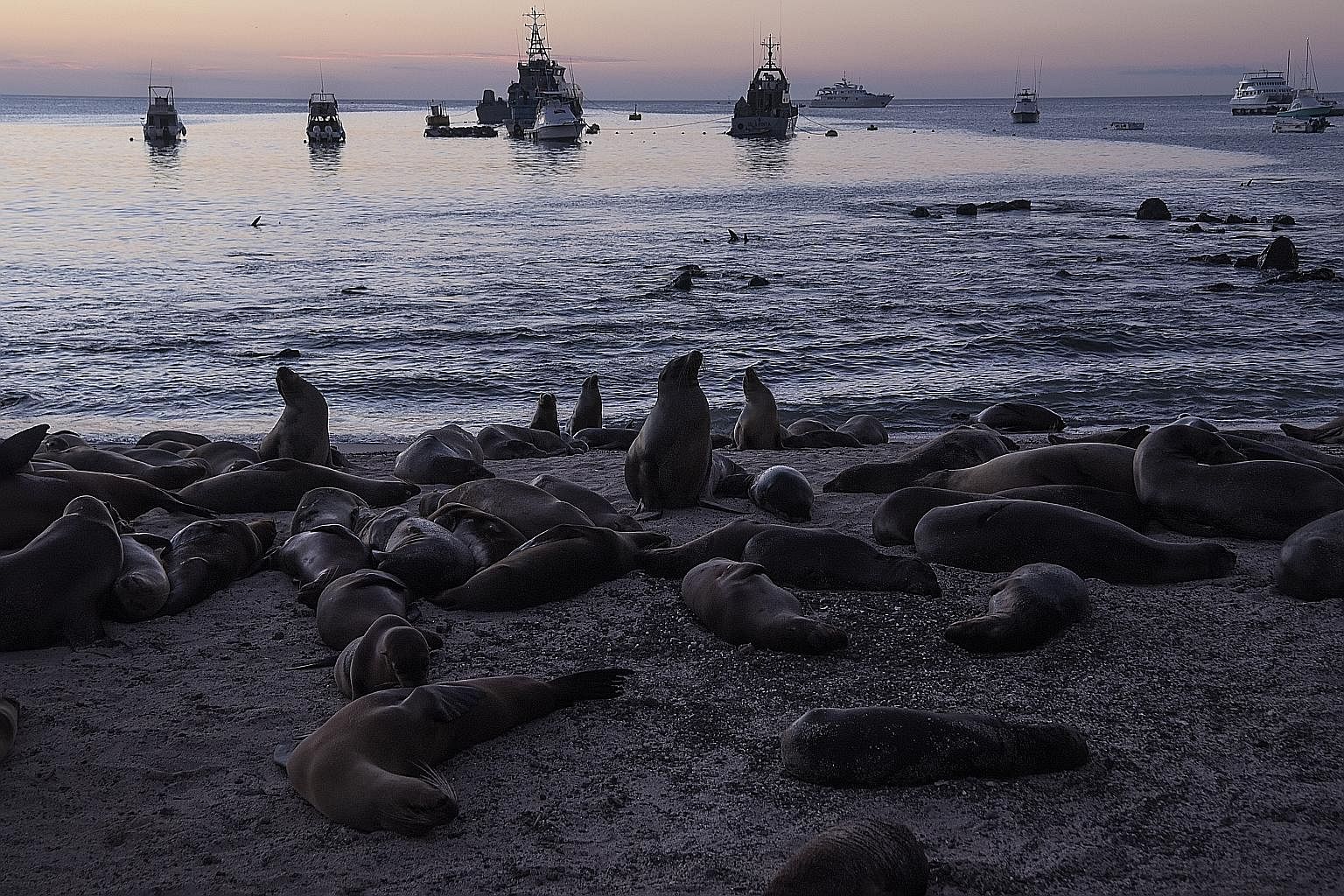
Off the coasts of Latin America, where some of the world's richest fisheries can be found, the impact of El Nino is hardest felt in the ocean.
The Galapagos penguin - the only penguin species that lives so close to the Equator - is perhaps the poster child for this.
On average, their numbers range between 2,000 and 4,000, says Dr Gustavo Jimenez, principal researcher for marine birds at the Charles Darwin Research Station.
But in the aftermath of the 1982 El Nino, their numbers plunged 80 per cent, leaving just 300 penguins, he tells The Sunday Times.
History repeated itself in 1997 when another strong El Nino hit the islands. That year, the penguin population fell 60 per cent, dwindling to 400, says Dr Jimenez.
The very reason for the penguins' high mortality during El Nino events is, ironically, also why this cool-adapted species can be found so near the Equator.
It all boils down to the way the currents swirl around the islands.
The Galapagos Islands lie at the crossroads of three major surface ocean currents in the Pacific Ocean: the cool South Equatorial and Humboldt currents that come from the east and the south-east respectively, and the warm Panama Current which streams down from the north-east.
The Galapagos also receives another subsurface current: The Cromwell undercurrent from the west helps the penguins thrive on the Isabela and Fernandina islands, located on the western end of the archipelago.
Said CI's Mr Banks: "The westerly Cromwell Current is a submarine current that sits between 50m and 100m below the surface.
"When it hits the western islands, it causes an upwelling, like a hose firing against the base of a platform."
The upwelling of cool, nutrient-rich water stimulates the oceanic food web, allowing phytoplankton - plants of the ocean - to bloom. This provides a buffet for fish that the penguins enjoy in turn.
It also provides a cool water refuge on the Equator.
El Nino and La Nina events, however, disrupt this status quo. La Nina is the sister to El Nino, bringing cool waters to the archipelago.
During these events, penguin numbers go up, says Dr Jimenez.
El Nino typically arrives on the Galapagos on a red "carpet" as warm water spreads across the Pacific Ocean. This is often depicted in maps as a swelling pool of red across the ocean basin.
As warm water journeys east, it pushes the cool water that usually upwells along the coasts of South America to deeper depths.
This means that the water which wells up is warm and nutrient-poor instead.
When this happens, the oceanic ecosystem starves from the bottom up, says Mr Banks.
Penguins are not the only casualties. After the 1982 El Nino, 95 per cent of coral on the islands bleached and died.
Bleaching occurs when water that is too warm causes coral to expel algae living in their tissues.
Marine iguanas - reptiles found only on the Galapagos - are also hit hard when higher water temperatures kill the algae that they scrape off the seafloor.
SLOWING THE TIDE OF INVASION
El Nino, however, affects different sectors in different ways.
Cattle ranger Geovanni Saigu, 37, owns a 50ha farm on the highlands of San Cristobal and believes increased rainfall can help some farms. "Rain helps to fill the reservoirs, and also helps the grass grow better, providing more food for the cows."
But not all farmers benefit. Vegetable farmers could suffer crop losses when too much rain drowns the tomato and cucumber plants.
Higher rainfall also helps alien species, such as blackberries and guava plants, grow better. When birds peck at the fruit and spread the seeds, the plants spread further.
Biologists consider invasive species detrimental to the pristine ecosystems, as they can out-compete native species and spread diseases.
Blackberries, for example, are threatening the endemic Scalesia forests on the island of Santa Cruz, said a 2017 scientific report.
Alien species of animals are also affecting nature's balance. Goats brought to the islands by early settlers consume endemic plants and damage the nests of giant tortoises with their foraging, says Mr Eduardo Espinoza, director for ecosystem services at the Galapagos National Park.
Amid globalisation, eradicating invasive species is practically impossible and projects to remove them do not come cheap, says Mr Espinoza. An initiative to remove goats from Isabela island cost US$8 million, he adds.
The Galapagos National Park is undertaking many efforts to slow the tide of invasion and reduce the impact of human activities.
All ports of entry to the islands have staff who inspect bags for agricultural products.
Tourism is also carefully managed - visitors must be accompanied by a guide in protected areas, and strict controls limit the number of tourists visiting certain areas.
These efforts are crucial for the islands, considering that the twin engines of the islands' economy - fisheries and eco-tourism - are heavily dependent on nature.
A 2016 report by the United Nations Educational, Scientific and Cultural Organisation, also known as Unesco, stated that tourism on the Galapagos generates US$418 million annually, of which US$61 million enters the local economy. This, said the report, accounts for 51 per cent of the islands' revenue.
However, climate change and global warming is not an issue that the Galapagos can combat on its own, says Mr Espinoza.
What the national park can do is mitigate the impact of human activity, so that natural ecosystems are more resilient to climatic shocks.
He says: "You will always have natural threats, like El Nino, and climate change is global. But if you add on other threats from humans, like invasive species, pollution or destruction of their natural habitats, it is an extra weight for them."
He adds: "Many people think resources are materials and things, like money or laptops. But nature is also a resource - it gives us the air we breathe, the water we drink. And on the Galapagos, our nature is what the tourists come to see."
Dr Guzman agrees. "We have to learn how to share our planet with the other animals and plants... because with our bad actions, we are deciding the future of the planet."
